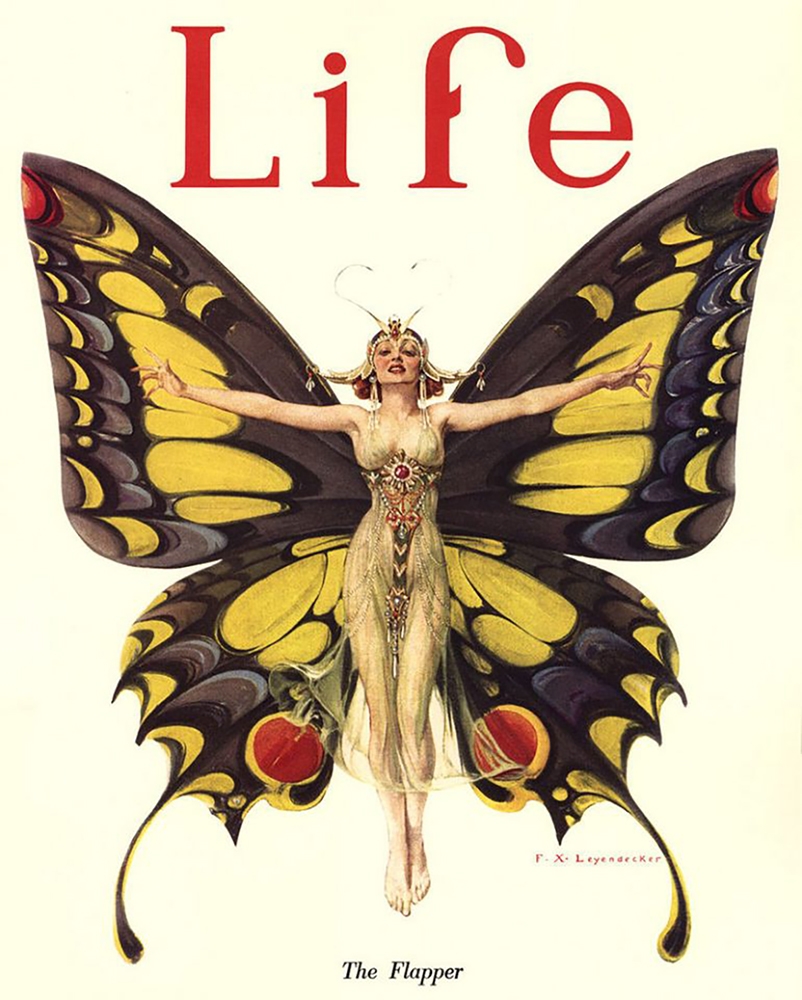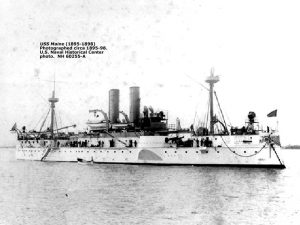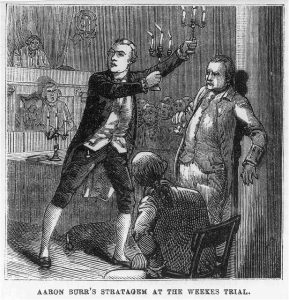Winner of the Fall 2016 StMU History Media Award for
Best Article in the Category of “Culture”
When one thinks of the 1920’s era one immediately thinks about Flappers. A flapper was considered a young woman who was very fashionable. This was a young female who enjoyed life to the fullest, flouting her unconventional standards of behavior and carefree party lifestyle.1 The spirit behind this movement was all about leaving the traditional ways of life behind and transforming into an independent woman.

Before World War I, the concept of femininity was referred to as the Gibson Girl. This term was used to describe these new independent and often well educated women. Gibson girls wore their hair long, pinned up and adorned with beautiful hats. They completed their ensemble by wearing long skirts and blouses that buttoned up to their necks. Despite their feminine appearance, these women were more than capable of doing the same things that men did. Examples of this include activities such as playing sports: skating, golfing, bicycling, tennis. These young ladies did not go out until they were asked properly by a young man who had good intentions and a promise of marrying them. Gibson Girls soon broke away from their traditional ways.2
In 1915, two years before America’s entry into World War I, a famous author by the name of H.L. Mencken introduced the word “Flapper” to the United States. Mencken stated that a flapper was “a woman who consumed music, literature and periodicals voraciously taking her cues for behavior and style from the media in front of her rather than the moral codes of decorum.”3 Another famous author, F. Scott Fitzgerald, famous for his classic novel The Great Gatsby, described the flapper as “lovely, expensive, and about nineteen.” John Held Jr., who was an American cartoonist, emphasized the flapper by drawing young girls wearing unbuckled galoshes that would make a “flapping” noise when walking.4 Despite the many different terms, Flappers were described essentially the same way: they were young girls who enjoyed the party life and had a sense of fashion.
After World War I ended in 1918, many things had changed for the men returning home, particularly the roles and values that women were embracing. The traditional values were gone and in their place came a faster, sleeker, and more daring approach to life. This time period not only ushered in an era of change in values, but it also established a new baseline for what was considered feminine. The Flapper Age was born and it brought with it a new and independent woman. These women smoked, drank, voted, cut their hair into bobs, wore eyeliner, and went to as many parties as they could—enjoying every bit of the social life along the way.5

During the 1920’s, fashion changed drastically due to a very famous designer, Coco Chanel. This woman helped flapper fashion to stand on its own. Typical flapper clothing included a simple sack like dress, which allowed women of all classes to make their own dresses and remain on trend.6 The waist of the dress was dropped to the hipline, and the skirt fell just below the knee. Stockings made of rayon were added and worn over a garter belt. To complete the look, bracelets were added and necklaces ran from the neck to the waist. Cloche hats sat atop their heads and drew the eye into a new hairstyle trend known as the bob.7 The make-up of flappers consisted of a red powder or cream that was used for the lips and cheek, eye-liner, powder for the face, and red lipstick that became very popular.
On January 19, 1919, the Eighteenth Amendment, also known as the Volstead Act, came into effect and gave way to the Prohibition Era in which the sale, production, importation, and transportation of alcohol was banned across the nation.8 This change in the legal system caused the sale and consumption of liquor and alcohol to go underground. The most rebellious thing a flapper could do at this time was to consume alcohol, and these young girls had a reputation for being giddy. The following year, on August 18, 1920, the Nineteenth Amendment was passed and women now had the right to vote.9 In 1924, the first radio launched more than 600 commercial channels around the U.S. The radio at the time was the social media on the flapper life. Many young girls swarmed the theaters to see the image of the flapper on screen. Famous actress Clara Bow, starred in the “Flapper” and made the look iconic.
On December 2, 1927, Henry Ford invented the Model A vehicle and car sales increased.10 Women were now owners of vehicles, and the car became a lifeline to a world full of excitement for the flapper in particular. With no one to stop them, they were free to come and go as they pleased. Liberated women were now able to go out and enjoy dancing during this era that was the Jazz Age. The most popular thing for a flapper to do was to go to a nightclub where she would drink, dance, and show off her moves. The era of the Flapper, however, came to an end with the Wall Street Crash of 1929. Many young women lost their jobs and the incomes that had given them such independence.11
Life in the 1920’s left a huge legacy for women to this day. Flappers and the forward-thinking concept of the modern woman is what initiated the change in society for how women were viewed then as well as how they continue to be viewed in present day. With their bold choice in attire, along with their new views and attitudes regarding femininity, both in fashion as well as social conduct, Flappers left behind the old traditional ways and paved the road for a more liberated female.
- Salem Press Biographical Encyclopedia, January 2016, s.v. “Flappers,” by R.L. Smith. ↵
- Kelly B. Sagert, Flappers: A Guide to an American Subculture (Greenwood Publishing Group, 2010), 1-2. ↵
- Brian DiPaolo, Flappers: Issues & Controversies in American History (Infobase Publishing, 2007), 4-5. ↵
- DiPaolo, Flappers: Issues & Controversies in American History, 4-5. ↵
- Soo Hyun Park, Flapper Fashion In the Context of Cultural Changes of America in the 1920’s (CUNY Academic Works, 2014), 1-2. ↵
- Salem Press Biographical Encyclopedia, January, 2016, s.v. “Flappers,” by R.L. Smith. ↵
- Sagert, Flappers: A Guide to an American Subculture, 3. ↵
- Sagert, Flappers: A Guide to an American Subculture, 5. ↵
- DiPaolo, Flappers: Issues & Controversies in American History, 2. ↵
- F.L. Allen, Only Yesterday: An Informal History of the Nineteen Twenties (National Humanities Center, 1931), 5. ↵
- Alan Brinkley, American History: Connecting with the Past Volume 2, 15 edition (New York: McGraw-Hill Education, 2014), 643. ↵




213 comments
Brianda Gomez
It is amazing how women have revolutionized how they dress, act, and their role in a family since the 1920s. I do not agree with women having to wait to go out until they were asked by a young man. We should be free and go where ever we want and be able to explore the world. It is also surprising that Chanel existed during the time of the “flappers” and that they wore red lipstick like we see many women today. I really enjoyed reading this article because it informed us more about these women that transformed life and went out of their comfort zone, broke the rules, and stopped following the duties of a typical house hold woman.
Clarissa Bustamante
This article was very informative! In my opinion, a flapper would been something great to be. It was such a fashion statement in this time period and it was also a way for women or girls to be rebellious and express themselves however way they wanted to. Flappers established a fundamental independent feminine ideology. It was great how this article stated that the flapper women went against the stereotypical ideas of how people should act.
Richard Navarro
The twenties set a huge mark for history in the U.S. many see this as a party era, many see this as an era of change. The lifestyles throughout the roaring twenties was quite interesting. The women back then were becoming more independent than usual and doing activities that seemed very odd and unusual at the time. This article was very interesting and describes flappers with absolutely amazing detail.
Thomas Fraire
Reading this article shows how far the women have evolved over time, it was a really informative read and I enjoyed it a lot. It is crazy that things like women drinking alcohol were completely taboo and not okay. This article shows the growth and how far this feminist movement has empowered and done for women in the United States of America since the 1920’s.
Abigale Carney
This article was very informative. I really like to read about how women evolve through time, and I feel like the 20’s is where it all started. These “flappers” were so confident which helped form women into the women we are today. For if these women were not so bold in the way they wore their clothes or cut their hair, women would probably not be where we are today. I believe that these women had a huge impact on the 19th amendment in allowing women to vote. These women have made such a great impact on our society, and I am so glad they were bold enough to start this women’s rights movement.
Faisal Alqarni
The flapper culture seems to have been an interesting time which it in a way brought about feminism pride as I see in your article these “Gibson girls or Flappers” were not mistreated by society for standing out and been aware, I like how you highlighted the different ways the flappers were understood and the fashion trends and the media that defined them. I think the present day equal of this flapper girls could be the socialites who go to every party and dress in a self-expressive manner that some in society would not approve of. Because of your article I now see these women such as the Kardashian’s in a different view, not rebels without a cause like my friend call them, but people advancing feminism in a new way and who are just carrying on the legacy of those who they came before them like you said.
Irene Astran
It is good to hear that women were also allowed to indulge themselves in the 20’s. I am forever grateful for these girls because it seems they were one of the first to reject traditional customs where you could only go with a boy if they had promised to marry you. With parties raging just outside my doors I would not want to wait for a boy to send for me either!
Aaron Mcglown
A really good article! Gave great insight on the reason behind the flapper movement and how it was a rebellious thing. The only time i heard of the flappers was in the great Gatsby movie so this article cleared up any questions that i might’ve had about the movement. Pretty nice to see how the women were free spirited and just living life to the fullest.
Gabriela Medrano
This article was very captivating! It was what I expected and more, especially the topic. You hear about flappers but history books touch on them briefly and its a real shame. Flappers are such interesting ladies and the impact they had on society reflects upon us still today. I found it interesting about the different factors that played into this role the woman had, such as the jazz music, Coco Chanel, and even renovations like cars. Congrats, great article, loved it!
Bailey Rider
I liked how in this article you talked about how the look of the flapper correlated with the position in society. When women became bolder in their style, they also became bolder in the way they looked at the world, going out and doing things that, traditionally, men would do. I also like how you pointed out that the role of women changed after World War 1, and the women did not go back to their old life styles but continued on. Thank you for an amazing article!